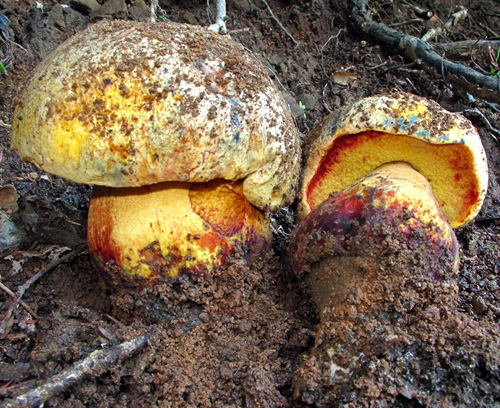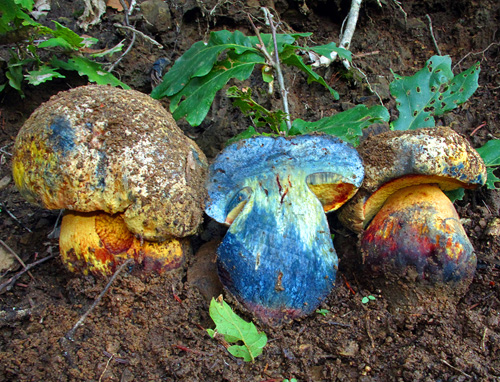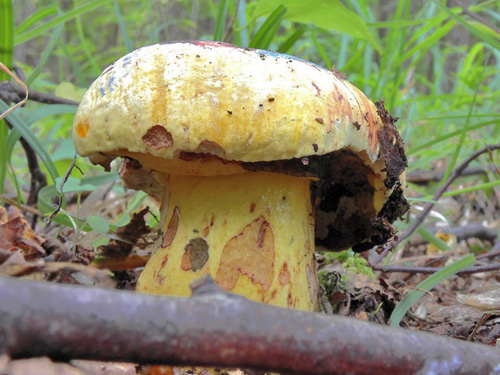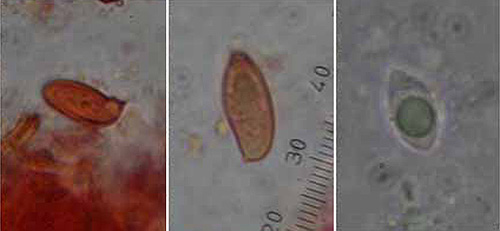Boletus L.
Recent molecular studies have shown that Boletus in its current circumscription is likely an artificial grouping and it is possible that it will be split at some point into smaller genera. Note that Boletus impolitus and Boletus depilatus for practical reasons are retained here, although there is strong evidence that they are closely related to Xerocomus subtomentosus and its allies.
Fruitbody large to medium sized, boletoid, without veil and ring. Stipe solid, with surface usually covered with granules or network. Flesh variously coloured, changing or not when exposed to air. Tubes easily separable from each other, not tearing apart. Pores usually small and rounded.
Boletus xanthocyaneus Ramain ex Romagnesi
A rarely seen bolete, which status is still much debated. Its specific status has been advocated by Brillouet & Brillouet (1993), Simonini (1998), Estadès & Deïana (2004) and Watling & Hills (2005). However, Muñoz (2005) includes remarks suggesting that he thinks of it as possible xanthoid form of Boletus torosus. Further research, including by molecular techniques will probably help to solve this problem. At this point the author is unable to take any side as this bolete is known to him only from the literature. Boletus xanthocyaneus is a bolete with stout fruitbodies with dense and heavy flesh, similarly to B. torosus. It is distinguished by entirely striking yellow fruitbodies, which turn blue-black at the slightest touch. The bright yellow cap remains so for a long time and sometimes with age may develop reddish, pinkish or violaceous-brownish hues. In B. torosus it is thought that greyish and olive tints prevail on the cap. It is also said that this bolete has agreeable fruity smell, opposed to the unpleasant smell of B. torosus. The distinction from the yellow forms of Boletus rhodopurpureus seems rather uncertain, especially in young fruitbodies, as these may sometimes lack the typical reddish-orange or red coloured pores. Compare also to Boletus poikilochromus.
Habitat. Warm broadleaf forests, usually (if not always) on neutral or acid soils, mycorrhizal with broadleaf trees, most probably Quercus.
Distribution. Seen rarely and collections are known from France, Greece, Italy, Spain and the United Kingdom.
Photographs

Fruitbodies of Boletus xanthocyaneus. Note the colours overall. (photo G. Konstantinidis)

Fruitbodies of Boletus xanthocyaneus. The strong blueing is typical characteristic of this species. (photo G. Konstandinis)

Fruitbody of Boletus xanthocyaneus. Note again the yellow colours. (photo L. Sartoni, determination N. Amalfi)

Fruitbody of Boletus xanthocyaneus. (photo L. Sartoni, determination N. Amalfi)

Spores of Boletus xanthocyaneus. (photo G. konstantinidis)
Important literature
Alessio, C.L. 1998. Boletus & Inocybe. – In: Fungi non delineati. Vol. 3. Pp. 1–40 + Pl. 1–8. Libreria Mykoflora, Alassio.
Brillouet, J.-M. & Brillouet, T. 1993. Descrizione comparativa di raccolte di Boletus xanthocyaneus Ramain ex Romagnesi e di Boletus torosus Fries. – Rivista di Micologia 36(1): 65–72.
Estadès, A. & Deïana, J.C. 2004. Boletus xanthocyaneus et Boletus torosus. Deux espèces distinctes. – Bulletin Mycologique et Botanique Dauphiné-Savoie 127: 15–30.
Galli, R. 1998. I Boleti. Atlante pratico-monographico per la determinazione dei boleti. Edinatura, Milano.
Hills, A. 1997. Notes on British species of the Boletus torosus complex. – Mycologist 11: 159–164.
Muñoz, J.A. 2005. Boletus s. l. – In: Fungi Europaei. Vol. 1. Pp. 1–951. Edizioni Candusso, Alassio.
Redeuilh, G. 1992. Contribution à l’étude des bolets. II: Etude critique de Boletus torosus et Boletus xanthocyaneus. – Bulletin trimestriel de la Société mycologique de France 108: 155–172.
Simonini, G. 1995. I Boleti della sezione Luridi a viraggio violento: problemi tassonomici. – Mycologia e Vegetazione Mediterranea 10: 88–112.
Simonini, G. 1998. Qualche specie rara o poco conosciuta della famiglia Boletaceae. – In: Fungi non delineati. Vol. 6. Pp. 1–56. Libreria Mykoflora, Alassio.
Watling, R. & Hills, A.E. 2005. Boletes and their allies (revised and enlarged edition). – In: Henderson, D.M., Orton, P.D. & Watling, R. [eds]. British Fungus Flora. Agarics and boleti. Vol. 1. Royal Botanic Garden, Edinburgh.